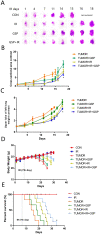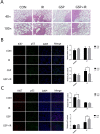Grape Seed Proanthocyanidins play the roles of radioprotection on Normal Lung and radiosensitization on Lung Cancer via differential regulation of the MAPK Signaling Pathway
- PMID: 33854585
- PMCID: PMC8040900
- DOI: 10.7150/jca.49987
Grape Seed Proanthocyanidins play the roles of radioprotection on Normal Lung and radiosensitization on Lung Cancer via differential regulation of the MAPK Signaling Pathway
Abstract
Radiation-induced lung injury (RILI) is a common serious complication and dose-limiting factor caused by radiotherapy for lung cancer. This study was to investigate radioprotective effects of grape seed proanthocyanidins (GSP) on normal lung as well as radiosensitizing effects on lung cancer. In vitro, we demonstrated radioprotective effects of GSP on normal alveolar epithelial cells (MLE-12 and BEAS/2B) and radiosensitizing effects on lung cancer cells (LLC and A549). In vivo, we confirmed these two-way effects in tumor-bearing mice. The results showed that GSP inhibited tumor growth, and played a synergistic killing effect with radiotherapy on lung cancer. Meanwhile, GSP reduced radiation damage to normal lung tissues. The two-way effects related to the differential regulation of the MAPK signaling pathway by GSP on normal lung and lung cancer. Moreover, GSP regulated secretion of cytokines IL-6 and IFN-γ and expression of p53 and Ki67 on normal lung and lung cancer. Our findings suggest that GSP is expected to be an ideal radioprotective drug for lung cancer patients who are treated with radiotherapy.
Keywords: MAPK; Proanthocyanidins; lung cancer; radioprotection; radiosensitization.
© The author(s).
Conflict of interest statement
Competing Interests: The authors have declared that no competing interest exists.
Figures







Similar articles
-
Grape seed proanthocyanidins ameliorates cadmium-induced renal injury and oxidative stress in experimental rats through the up-regulation of nuclear related factor 2 and antioxidant responsive elements.Biochem Cell Biol. 2015 Jun;93(3):210-26. doi: 10.1139/bcb-2014-0114. Epub 2014 Dec 11. Biochem Cell Biol. 2015. Retraction in: Biochem Cell Biol. 2020 Apr;98(2):307. doi: 10.1139/bcb-2020-0070. PMID: 25719599 Retracted.
-
[Grape seed proanthocyanidins inhibits the invasion and migration of A549 lung cancer cells].Xi Bao Yu Fen Zi Mian Yi Xue Za Zhi. 2016 Feb;32(2):173-6. Xi Bao Yu Fen Zi Mian Yi Xue Za Zhi. 2016. PMID: 26927375 Chinese.
-
Grape seed proanthocyanidin inhibits inflammatory responses in hepatic stellate cells by modulating the MAPK, Akt and NF-κB signaling pathways.Int J Mol Med. 2017 Jul;40(1):226-234. doi: 10.3892/ijmm.2017.2997. Epub 2017 May 19. Int J Mol Med. 2017. PMID: 28534957
-
Free radical scavenging, antioxidant and cancer chemoprevention by grape seed proanthocyanidin: an overview.Mutat Res. 2014 Oct;768:69-73. doi: 10.1016/j.mrfmmm.2014.04.004. Epub 2014 Apr 19. Mutat Res. 2014. PMID: 24751946 Review.
-
COX-2 in Radiotherapy: A Potential Target for Radioprotection and Radiosensitization.Curr Mol Pharmacol. 2018;11(3):173-183. doi: 10.2174/1874467211666180219102520. Curr Mol Pharmacol. 2018. PMID: 29468988 Review.
Cited by
-
Grape seed powder increases gastrointestinal motility.Int J Med Sci. 2022 May 21;19(5):941-951. doi: 10.7150/ijms.72529. eCollection 2022. Int J Med Sci. 2022. PMID: 35693751 Free PMC article.
-
Proanthocyanidins-loaded complex coacervates-based drug delivery attenuates oral squamous cell carcinoma cells metastatic potential through down-regulating the Akt signaling pathway.Front Oncol. 2022 Oct 18;12:1001126. doi: 10.3389/fonc.2022.1001126. eCollection 2022. Front Oncol. 2022. PMID: 36330492 Free PMC article.
-
Dietary Phytochemicals as Potential Chemopreventive Agents against Tobacco-Induced Lung Carcinogenesis.Nutrients. 2023 Jan 17;15(3):491. doi: 10.3390/nu15030491. Nutrients. 2023. PMID: 36771198 Free PMC article. Review.
-
Tissue fibrosis induced by radiotherapy: current understanding of the molecular mechanisms, diagnosis and therapeutic advances.J Transl Med. 2023 Oct 9;21(1):708. doi: 10.1186/s12967-023-04554-0. J Transl Med. 2023. PMID: 37814303 Free PMC article. Review.
-
Quantitative phosphoproteomic analysis reveals chemoresistance-related proteins and signaling pathways induced by rhIL-6 in human osteosarcoma cells.Cancer Cell Int. 2021 Oct 30;21(1):581. doi: 10.1186/s12935-021-02286-z. Cancer Cell Int. 2021. PMID: 34717622 Free PMC article.
References
-
- Miller KD, Nogueira L, Mariotto AB. et al. Cancer treatment and survivorship statistics, 2019. CA Cancer J Clin. 2019;69(5):363–385. - PubMed
-
- Stahl JM, Corso CD, Verma V. et al. Trends in stereotactic body radiation therapy for stage I small cell lung cancer. Lung Cancer. 2017;103:11–16. - PubMed
-
- Kong FM, Hayman JA, Griffith KA. et al. Final toxicity results of a radiation-dose escalation study in patients with non-small-cell lung cancer (NSCLC): predictors for radiation pneumonitis and fibrosis. Int J Radiat Oncol Biol Phys. 2006;65(4):1075–86. - PubMed
LinkOut - more resources
Full Text Sources
Other Literature Sources
Research Materials
Miscellaneous

